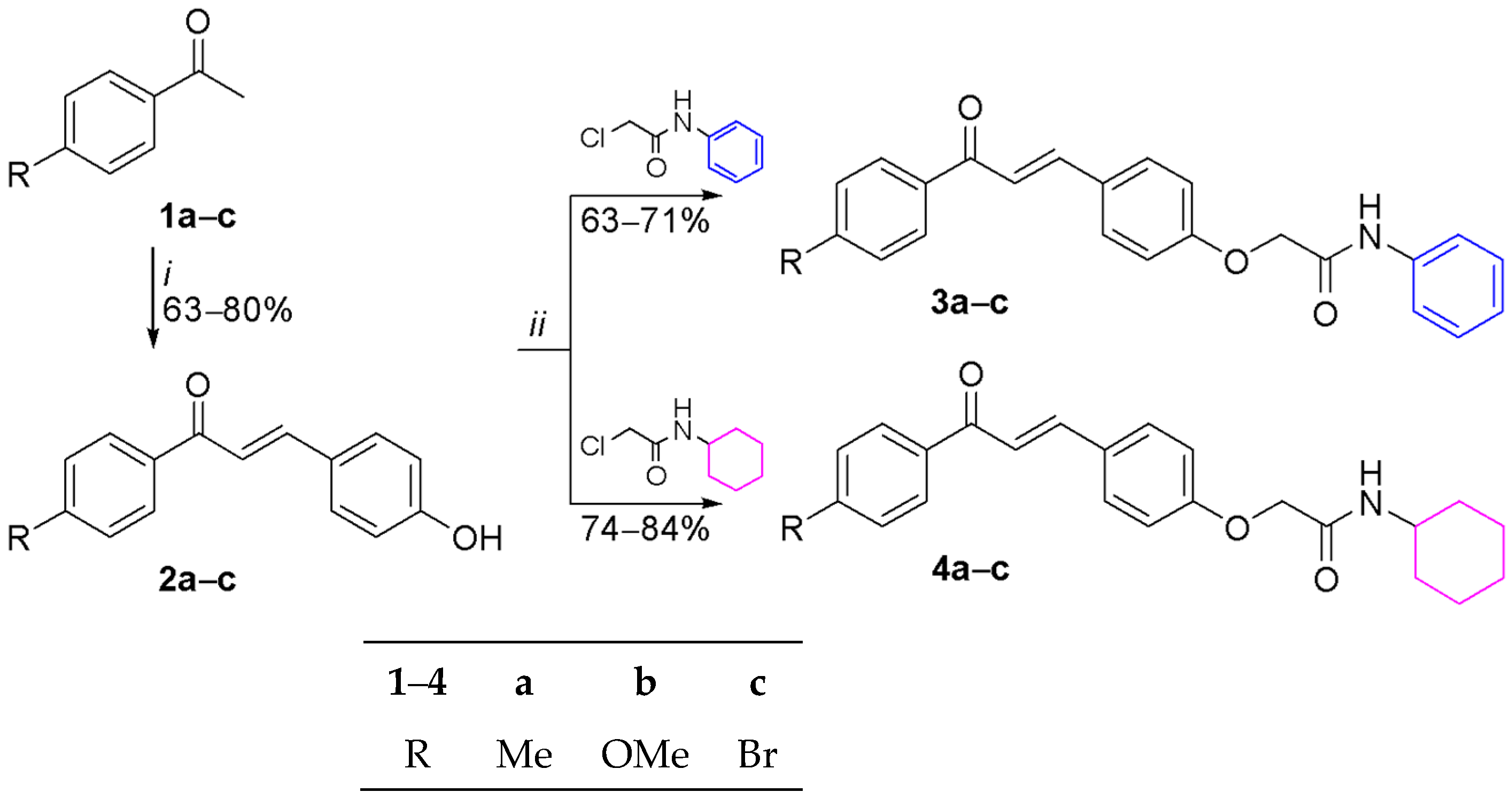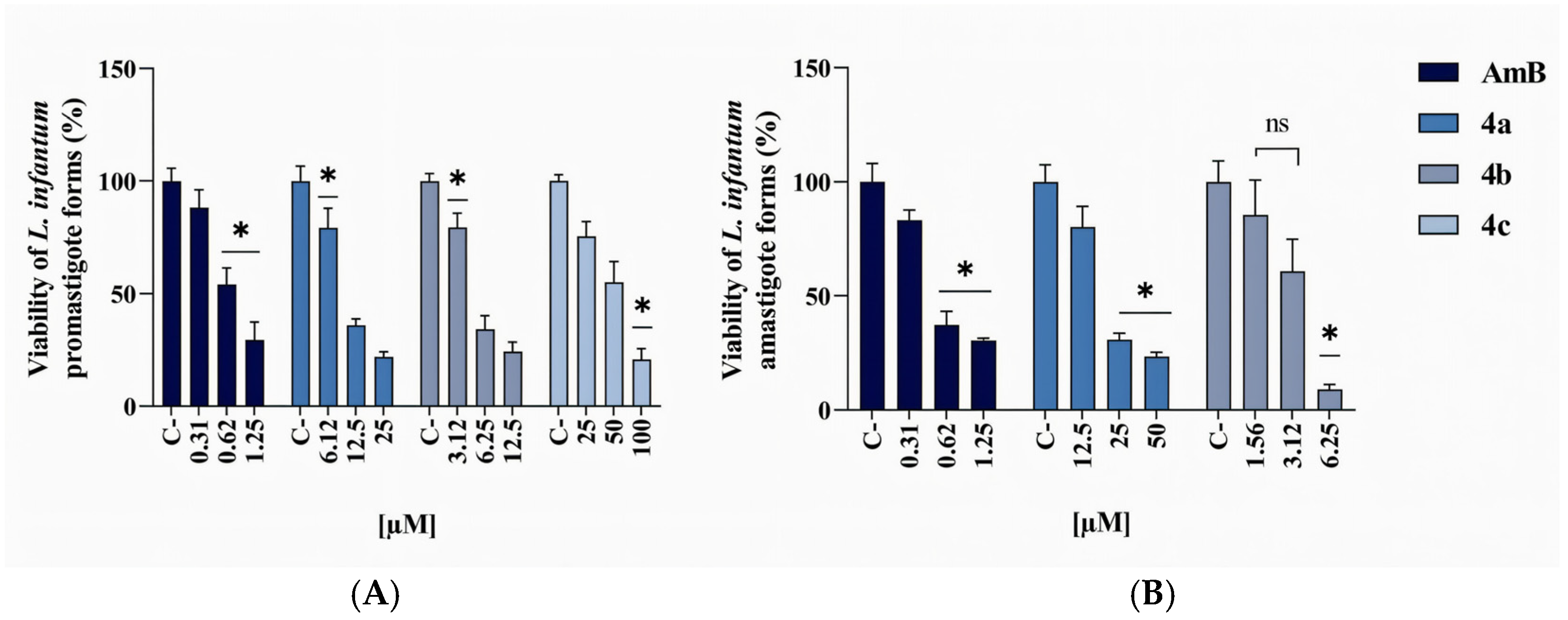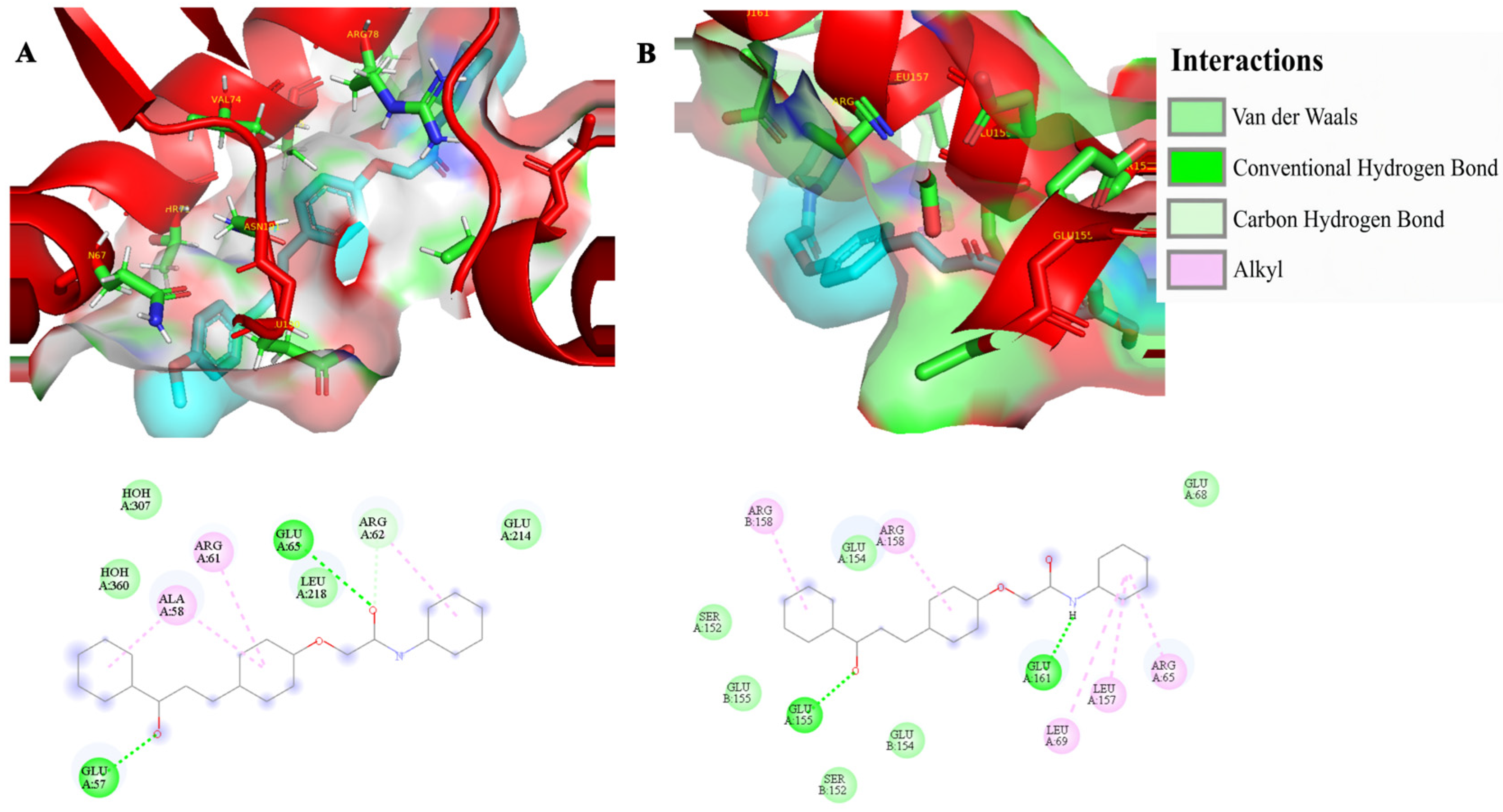Novel Chalcone Derivatives as Anti-Leishmania infantum Agents with Potential Synergistic Activity and In Silico Insights
Abstract
1. Introduction
2. Results
2.1. Synthesis of Chalcone–Acetamides
2.2. Assessment of Inhibitory Effects Against L. infantum
2.3. Evaluation of Cytotoxicity in Human Cells and Selectivity Index Calculation
2.4. In Silico Insights
2.5. Synergistic Activity Between Compound 4b and AmB
3. Discussion
4. Materials and Methods
4.1. Reagents and Instrumentation
4.2. General Procedure for Synthesis of 2-Chloro-N-Phenylacetamide and 2-Chloro-N-Cyclohexylacetamide
4.3. General Procedure for Synthesis of 4-Hydroxychalcones (2a–c)
4.4. General Procedure for Synthesis of Chalcone–Acetamides (3a–c, 4a–c)
4.5. Reference Drug
4.6. Leishmania Culture Conditions
4.7. In Vitro Leishmanicidal Activity in Promastigote and Amastigote Forms of L. infantum
4.8. Cytotoxicity in Human Erythrocytes and Peripheral Blood Mononuclear Cells (PBMCs) Assay
4.9. In Silico Assays
4.10. Synergistic Activity
4.11. Statistical Analysis
5. Conclusions
Supplementary Materials
Author Contributions
Funding
Institutional Review Board Statement
Informed Consent Statement
Data Availability Statement
Acknowledgments
Conflicts of Interest
References
- Álvarez-Hernández, D.A.; Rivero-Zambrano, L.; Martínez-Juárez, L.A.; García-Rodríguez-Arana, R. Overcoming the global burden of neglected tropical diseases. Ther. Adv. Infect. Dis. 2020, 7, 2049936120966449. [Google Scholar] [CrossRef] [PubMed]
- Brindha, J.; Balamurali, M.M.; Chanda, K. An overview on the therapeutics of neglected infectious diseases—Leishmaniasis and Chagas diseases. Front. Chem. 2021, 9, 622286. [Google Scholar] [CrossRef]
- Yasmin, H.; Adhikary, A.; Al-Ahdal, M.N.; Roy, S.; Kishore, U. Host–pathogen interaction in leishmaniasis: Immune response and vaccination strategies. Immuno 2022, 2, 218–254. [Google Scholar] [CrossRef]
- Pan-American Health Organization (PAHO). Leishmaniasis: Epidemiological Report of the Americas Region. 2024. Available online: https://iris.paho.org/handle/10665.2/51742 (accessed on 3 November 2025).
- Kumari, S.; Kumar, V.; Tiwari, R.K.; Ravidas, V.; Pandey, K.; Kumar, A. Amphotericin B: A drug of choice for Visceral Leishmaniasis. Acta Trop. 2022, 235, 106661. [Google Scholar] [CrossRef]
- Novais, F.O.; Amorim, C.F.; Scott, P. Host-directed therapies for cutaneous leishmaniasis. Front. Immunol. 2021, 12, 660183. [Google Scholar] [CrossRef] [PubMed]
- Singh, P.; Anand, A.; Kumar, V. Recent developments in biological activities of chalcones: A mini review. Eur. J. Med. Chem. 2014, 85, 758–777. [Google Scholar] [CrossRef]
- Tajuddeen, N.; Isah, M.B.; Suleiman, M.A.; van Heerden, F.R.; Ibrahim, M.A. The chemotherapeutic potential of chalcones against leishmaniases: A review. Int. J. Antimicrob. Agents 2018, 51, 311–318. [Google Scholar] [CrossRef]
- de Mello, M.V.P.; de Azevedo Abrahim-Vieira, B.; Domingos, T.F.S.; de Jesus, J.B.; de Sousa, A.C.C.; Rodrigues, C.R.; de Souza, A.M.T. A comprehensive review of chalcone derivatives as antileishmanial agents. Eur. J. Med. Chem. 2019, 150, 920–929. [Google Scholar] [CrossRef] [PubMed]
- Al-Ostoot, F.H.; Zabiulla; Salah, S.; Khanum, S.A. Recent investigations into synthesis and pharmacological activities of phenoxy acetamide and its derivatives (chalcone, indole and quinoline) as possible therapeutic candidates. J. Iran. Chem. Soc. 2021, 18, 1839–1875. [Google Scholar] [CrossRef]
- Santiago-Silva, K.M.; Bortoleti, B.T.D.S.; Oliveira, L.D.N.; Maia, F.L.A.; Castro, J.C.; Costa, I.C.; Lazarin, D.B.; Wardell, J.L.; Wardell, S.M.S.V.; Albuquerque, M.G. Antileishmanial Activity of 4,8-Dimethoxynaphthalenyl Chalcones on Leishmania amazonensis. Antibiotics 2022, 11, 1402. [Google Scholar] [CrossRef]
- Ayaz, M.; Ullah, F.; Sadiq, A.; Ullah, F.; Ovais, M.; Ahmed, J.; Devkota, H.P. Synergistic interactions of phytochemicals with antimicrobial agents: Potential strategy to counteract drug resistance. Chem. Biol. Interact. 2019, 308, 294–303. [Google Scholar] [CrossRef]
- Borges, B.S.; Bueno, G.D.P.; Tomiotto-Pellissier, F.; Figueiredo, F.B.; Medeiros, L.C.S. In vitro anti-Leishmania activity of triclabendazole and its synergic effect with amphotericin B. Front. Cell. Infect. Microbiol. 2023, 12, 1044665. [Google Scholar] [CrossRef]
- Chanmol, W.; Siriyasatien, P.; Intakhan, N. In vitro anti-Leishmania activity of 8-hydroxyquinoline and its synergistic effect with amphotericin B deoxycholate against Leishmania martiniquensis. PeerJ 2022, 10, e12813. [Google Scholar] [CrossRef]
- Shoaib, M.; Aygun, A.L.; Ganbarov, K. Cyclohexane and its functionally substituted derivatives: Important class of organic compounds with potential antimicrobial activities. J. Microbiol. Biotechnol. Food Sci. 2019, 9, 84. [Google Scholar] [CrossRef]
- Passalacqua, T.G.; Dutra, L.A.; de Almeida, L.; Velásquez, A.M.A.; Torres, F.A.E.; Yamasaki, P.R.; Santos, M.B.; Regasini, L.O.; Michels, P.A.M.; Bolzani, V.S.; et al. Synthesis and evaluation of novel prenylated chalcone derivatives as anti-leishmanial and anti-trypanosomal compounds. Bioorg. Med. Chem. Lett. 2015, 25, 3342–3345. [Google Scholar] [CrossRef] [PubMed]
- Leite, F.F.; Rodrigues, L.C.; Oliveira, B.H.M.D.; Duarte, G.D.; Leite Ferreira, M.D.; Sousa, N.F.D.; Vanderley, S.E.R.; Cardoso, L.L.; Keesen, T.S.L.; Araújo, R.S.; et al. In vitro and in silico evaluation of the anti-Leishmania activity of synthetic chalcones. Nat. Prod. Res. 2024, 1–12. [Google Scholar] [CrossRef] [PubMed]
- Gupta, S.; Shivahare, R.; Korthikunta, V.; Singh, R.; Gupta, S.; Tadigoppula, N. Synthesis and biological evaluation of chalcones as potential antileishmanial agents. Eur. J. Med. Chem. 2014, 81, 359–366. [Google Scholar] [CrossRef]
- de Oliveira, N.S.; de Souza, L.G.; de Almeida, V.M.; Barreto, A.R.; Carvalho-Gondim, F.; Schaeffer, E.; Santos-Filho, O.A.; Rossi-Bergmann, B.; da Silva, A.J. Synthesis and evaluation of hybrid sulfonamide-chalcones with potential antileishmanial activity. Arch. Pharm. 2024, 357, 2300440. [Google Scholar] [CrossRef]
- Gomes, M.N.; Alcantara, L.M.; Neves, B.J.; Melo-Filho, C.C.; Freitas-Junior, L.H.; Moraes, C.B.; Ma, R.; Franzblau, S.G.; Muratov, E.; Andrade, C.H. Computer-aided discovery of two novel chalcone-like compounds active and selective against Leishmania infantum. Bioorganic Med. Chem. Lett. 2017, 27, 2459–2464. [Google Scholar] [CrossRef]
- Hernández-Rivera, J.L.; Espinoza-Hicks, J.C.; Chacón-Vargas, K.F.; Carrillo-Campos, J.; Sánchez-Torres, L.E.; Camacho-Dávila, A.A. Synthesis, characterization and evaluation of prenylated chalcones ethers as promising antileishmanial compounds. Mol. Divers. 2023, 27, 2073–2092. [Google Scholar] [CrossRef]
- Shivahare, R.; Korthikunta, V.; Chandasana, H.; Suthar, M.K.; Agnihotri, P.; Vishwakarma, P.; Tadigoppula, N. Synthesis, structure–activity relationships, and biological studies of chromenochalcones as potential antileishmanial agents. J. Med. Chem. 2014, 57, 3342–3357. [Google Scholar] [CrossRef]
- Chen, J.E.; Huang, C.C.; Ferrin, T.E. RRDistMaps: A UCSF Chimera tool for viewing and comparing protein distance maps. Bioinformatics 2015, 31, 1484–1486. [Google Scholar] [CrossRef] [PubMed]
- Morris, G.M.; Huey, R.; Olson, A.J. Using AutoDock for ligand–receptor docking. Curr. Protoc. Bioinform. 2008, 24, 8–14. [Google Scholar] [CrossRef]
- Trott, O.; Olson, A.J. AutoDock Vina: Improving the speed and accuracy of docking with a new scoring function, efficient optimization and multithreading. J. Comput. Chem. 2010, 31, 455–461. [Google Scholar] [CrossRef] [PubMed]
- DeLano, W.L. PyMOL: An open-source molecular graphics tool. CCP4 Newsl. Protein Crystallogr. 2002, 40, 82–92. [Google Scholar]
- Dassault Systèmes. Discovery Studio Visualizer, version 17.2.0; BIOVIA: San Diego, CA, USA, 2017. Available online: https://www.3ds.com/ (accessed on 3 November 2025).
- Pires, D.E.V.; Blundell, T.L.; Ascher, D.B. pkCSM: Predicting small-molecule pharmacokinetic and toxicity properties using graph-based signatures. J. Med. Chem. 2015, 58, 4066–4072. [Google Scholar] [CrossRef]
- Daina, A.; Michielin, O.; Zoete, V. SwissADME: A free web tool to evaluate pharmacokinetics, drug-likeness and medicinal chemistry friendliness of small molecules. Sci. Rep. 2017, 7, 42717. [Google Scholar] [CrossRef]
- Banerjee, P.; Eckert, A.O.; Schrey, A.K.; Preissner, R. ProTox-II: A webserver for the prediction of toxicity of chemicals. Nucleic Acids Res. 2018, 46, 257–263. [Google Scholar] [CrossRef]
- Kumar, P.; Kumar, P.; Mandal, D.; Velayutham, R. The emerging role of deubiquitinases (DUBs) in parasites: A foresight review. Front. Cell. Infect. Microbiol. 2022, 12, 985178. [Google Scholar] [CrossRef]
- Damianou, A.; Burge, R.J.; Catta-Preta, C.M.; Geoghegan, V.; Nievas, Y.R.; Newling, K.; Mottram, J.C. Essential roles for deubiquitination in Leishmania life cycle progression. PLoS Pathog. 2020, 16, e1008455. [Google Scholar] [CrossRef]
- Das, S.; Saha, T.; Yadav, S.; Shaha, C. A novel role of secretory cytosolic tryparedoxin peroxidase in delaying apoptosis of Leishmania-infected macrophages. Mol. Cell. Biol. 2022, 42, e00081-22. [Google Scholar] [CrossRef]
- Wang, Y.H.; Dong, H.H.; Zhao, F.; Wang, J.; Yan, F.; Jiang, Y.Y.; Jin, Y.S. The synthesis and synergistic antifungal effects of chalcones against drug resistant Candida albicans. Bioorg. Med. Chem. Lett. 2016, 26, 3098–3102. [Google Scholar] [CrossRef]
- Maschio-Lima, T.; Lemes, T.H.; Marques, M.D.R.; Siqueira, J.P.Z.; de Almeida, B.G.; Caruso, G.R.; Kress, M.R.V.Z.; da Costa, P.T.; Regasini, L.O.; de Almeida, M.T.G. Synergistic activity between conventional antifungals and chalcone-derived compound against dermatophyte fungi and Candida spp. Int. Microbiol. 2025, 28, 265–275. [Google Scholar] [CrossRef]
- Costa, D.P.; Sousa, A.P.; Cardoso, L.L.; Vanderley, S.E.R.; Almeida, F.S.; Keesen, T.S.L.; Brito, T.A.M.; Silva, M.S.; Athayde-Filho, P.F.; Fiss, G.F. Novel 2-acetanilide 2-arylquinoline-4-carboxylates as antileishmanial agents: From prediction to in vitro activity/toxicity. Curr. Org. Chem. 2025, 29, e13852728371713. [Google Scholar] [CrossRef]
- Pace, V.; Castoldi, L.; Mamuye, A.D.; Holzer, W. Homologation of isocyanates with lithium carbenoids: A straightforward access to α-halomethyl- and α,α-dihalomethylamides. Synthesis 2014, 46, 2897–2909. [Google Scholar] [CrossRef]
- Sousa, A.P.; Souza, H.D.S.; Almeida-Júnior, A.; Silva, M.F.R.; Cordeiro, L.V.; Lima, E.O.L.; Fiss, G.F.; Athayde-Filho, P.F. Novel esters derived from 4-hydroxychalcones as potential sunscreens with antimicrobial action. Synth. Commun. 2024, 54, 973–991. [Google Scholar] [CrossRef]
- Tien, C.N.; Quoc, T.V.; Dang, D.N.; Duc, G.L.; Meervelt, L.V. Synthesis and structure of (E)-N-(4-methoxyphenyl)-2-[4-(3-oxo-3-phenylprop-1-en-1-yl)phenoxy]-acetamide. Acta Cryst. E 2021, 77, 184–189. [Google Scholar] [CrossRef] [PubMed]
- Debrabant, A.; Joshi, M.B.; Pimenta, P.F.; Dwyer, D.M. Generation of Leishmania donovani axenic amastigotes: Their growth and biological characteristics. Int. J. Parasitol. 2004, 34, 205–217. [Google Scholar] [CrossRef]
- Van de Ven, H.; Paulussen, C.; Feijens, P.B.; Matheeussen, A.; Rombaut, P.; Kayaert, P.; Mooter, G.V.; Weyenberg, W.; Cos, P.; Maes, L.; et al. PLGA nanoparticles and nanosuspensions with amphotericin B: Potent in vitro and in vivo alternatives to Fungizone and AmBisome. J. Control. Release 2012, 161, 795–803. [Google Scholar] [CrossRef]
- Berman, H.M.; Westbrook, J.; Feng, Z.; Gilliland, G.; Bhat, T.N.; Weissig, H.; Shindyalov, I.N.; Bourne, P.E. The Protein Data Bank. Nucleic Acids Res. 2000, 28, 235–242. [Google Scholar] [CrossRef]
- Brannigan, J.A.; Kamran, M.; Jones, N.G.; Nightingale, E.M.; Dodson, E.J.; Ejazi, S.A.; Wilkinson, A.J. Structure and activity of the essential UCH family deubiquitinase DUB16 from Leishmania donovani. Biochem. J. 2025, 482, 969–988. [Google Scholar] [CrossRef] [PubMed]
- Fiorillo, A.; Colotti, G.; Boffi, A.; Baiocco, P.; Ilari, A. The crystal structures of the tryparedoxin–tryparedoxin peroxidase couple unveil the structural determinants of Leishmania detoxification pathway. Protein Sci. 2012, 21, 1490–1501. [Google Scholar] [CrossRef] [PubMed]
- O’Boyle, N.M.; Banck, T.; James, C.A.; Morley, C.; Vandermeersch, T.; Hutchison, G.R. Open Babel: An open chemical toolbox. J. Cheminform. 2011, 3, 33. [Google Scholar] [CrossRef] [PubMed]
- Chou, T.C. Drug combination studies and their synergy quantification using the Chou-Talalay method. Cancer Res. 2010, 70, 440–446. [Google Scholar] [CrossRef]





| Compound | CC50 (CI) | Promastigotes IC50 (CI) | SI | Amastigotes IC50 (CI) | SI |
|---|---|---|---|---|---|
| 4a | 157.1 μM (105.6 to 241.8) | 12.9 µM (9.81 to 17.01) | 12.2 | 19.65 µM (11.9 to 33.2) | 8 |
| 4b | 505.4 μM (333.6 to 914.3) | 7.02 µM (3.73 to 15.48) | 72 | 3.4 µM (2.99 to 3.9) | 148.6 |
| AmB | 29.9 µM (19.15 to 53.4) | 0.87 µM (0.56 to 1.41) | 34.4 | 0.89 µM (0.43 to 2.1) | 33.6 |
| Compound | Class | LD50 (mg/kg−1) | Caco-2 | P-gp Inhibitor | CYP2D6 Inhibitor | Log Po/w | TPSA | Lipinski Violations |
|---|---|---|---|---|---|---|---|---|
| 4a | 4 | 1600 | 1.474 | Yes | No | 4.35 | 55.4 | 0 |
| 4b | 4 | 1600 | 0.651 | Yes | No | 4.02 | 64.63 | 0 |
Disclaimer/Publisher’s Note: The statements, opinions and data contained in all publications are solely those of the individual author(s) and contributor(s) and not of MDPI and/or the editor(s). MDPI and/or the editor(s) disclaim responsibility for any injury to people or property resulting from any ideas, methods, instructions or products referred to in the content. |
© 2025 by the authors. Licensee MDPI, Basel, Switzerland. This article is an open access article distributed under the terms and conditions of the Creative Commons Attribution (CC BY) license (https://creativecommons.org/licenses/by/4.0/).
Share and Cite
Fernandes, A.L.M.; Sousa, A.P.; Lamec, D.T.F.; Cardoso, L.L.; Ferreira, R.S.; Vanderley, S.E.R.; Athayde-Filho, P.F.; Fiss, G.F.; Keesen, T.S.L. Novel Chalcone Derivatives as Anti-Leishmania infantum Agents with Potential Synergistic Activity and In Silico Insights. Antibiotics 2025, 14, 1123. https://doi.org/10.3390/antibiotics14111123
Fernandes ALM, Sousa AP, Lamec DTF, Cardoso LL, Ferreira RS, Vanderley SER, Athayde-Filho PF, Fiss GF, Keesen TSL. Novel Chalcone Derivatives as Anti-Leishmania infantum Agents with Potential Synergistic Activity and In Silico Insights. Antibiotics. 2025; 14(11):1123. https://doi.org/10.3390/antibiotics14111123
Chicago/Turabian StyleFernandes, Ana Letícia Monteiro, Abraão Pinheiro Sousa, Delva Thyares Fonseca Lamec, Leonardo Lima Cardoso, Rosália Santos Ferreira, Shayenne Eduarda Ramos Vanderley, Petrônio Filgueiras Athayde-Filho, Gabriela Fehn Fiss, and Tatjana Souza Lima Keesen. 2025. "Novel Chalcone Derivatives as Anti-Leishmania infantum Agents with Potential Synergistic Activity and In Silico Insights" Antibiotics 14, no. 11: 1123. https://doi.org/10.3390/antibiotics14111123
APA StyleFernandes, A. L. M., Sousa, A. P., Lamec, D. T. F., Cardoso, L. L., Ferreira, R. S., Vanderley, S. E. R., Athayde-Filho, P. F., Fiss, G. F., & Keesen, T. S. L. (2025). Novel Chalcone Derivatives as Anti-Leishmania infantum Agents with Potential Synergistic Activity and In Silico Insights. Antibiotics, 14(11), 1123. https://doi.org/10.3390/antibiotics14111123







